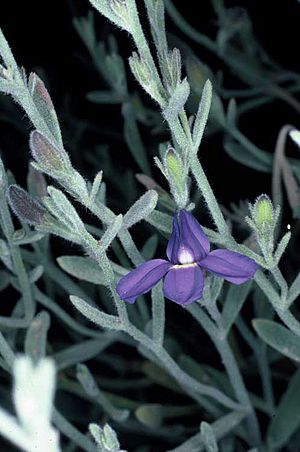Goodenia incana facts for kids
Quick facts for kids Goodenia incana |
|
|---|---|
 |
|
| In the Australian National Botanic Gardens | |
| Scientific classification | |
| Genus: |
Goodenia
|
| Species: |
incana
|
| Synonyms | |
|
Scaevola pterosperma de Vriese |
|
Goodenia incana is a special kind of flowering plant. It belongs to the Goodeniaceae family. This plant is found only in the south-west part of Western Australia. It's a small, upright plant covered in soft, silvery-white hairs. Its leaves are long and narrow, mostly growing near the bottom. When it blooms, you'll see beautiful blue flowers arranged in clusters.
Contents
What it Looks Like
Goodenia incana is a small, upright plant. It usually grows to about 30 cm (12 in) tall. The whole plant is covered in shiny, silvery-white hairs. This gives it a soft, fuzzy look.
Leaves and Stems
The leaves of this plant are shaped like a spear, but narrower at the base. Most of them grow from the bottom of the plant. They are usually 20–40 mm (0.79–1.57 in) long and 3–8 mm (0.12–0.31 in) wide.
Flowers and Fruit
The blue flowers grow in long clusters called racemes. These clusters can be up to 200 mm (7.9 in) long. Each flower has small, leaf-like parts called bracteoles that are 6–12 mm (0.24–0.47 in) long. The flowers sit on short stalks, or pedicels, which are 2–5 mm (0.079–0.197 in) long.
The flowers have special green leaves called sepals, which are 4–7 mm (0.16–0.28 in) long. The petals are a lovely blue color and are 12–15 mm (0.47–0.59 in) long. The lower parts of the flower's petals are about 6–7 mm (0.24–0.28 in) long. They also have small "wings" that are about 2 mm (0.079 in) wide.
Goodenia incana mostly flowers from September to January. After the flowers, the plant produces a small, oval-shaped fruit. This fruit is called a capsule and is about 8–9 mm (0.31–0.35 in) long.
How it Got its Name
Every plant has a scientific name, like Goodenia incana. This helps scientists around the world know exactly which plant they are talking about.
Discovery and Naming
The plant was first officially described in 1810. A famous botanist named Robert Brown gave it its name. He wrote about it in his book, Prodromus Florae Novae Hollandiae et Insulae Van Diemen.
Meaning of the Name
The second part of its name, incana, is a Latin word. It means "grey" or "hoary." This describes the silvery-white hairs that cover the plant. It's a perfect name for this fuzzy plant!
Where it Lives
This type of goodenia plant loves sandy soil. You can find it growing in areas with heathland and forests. It is quite common and spread out across the south-west region of Western Australia.

